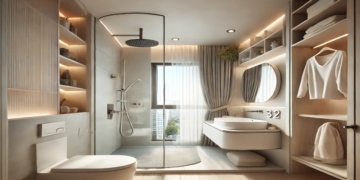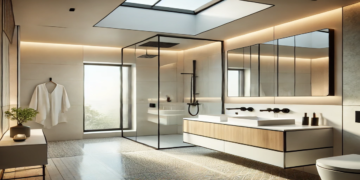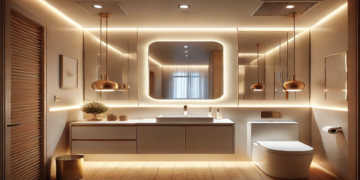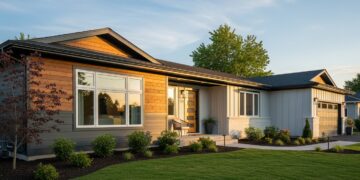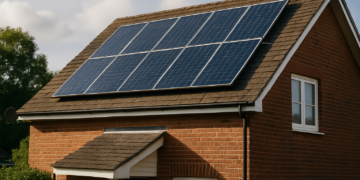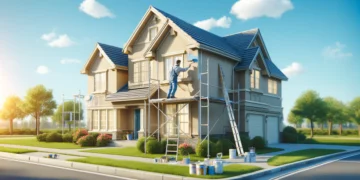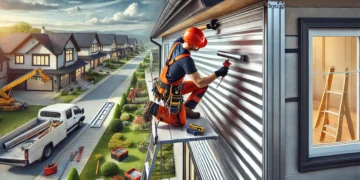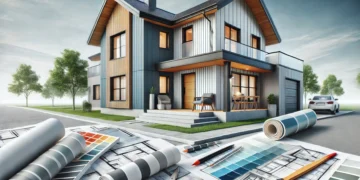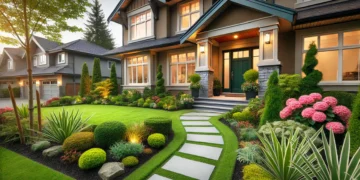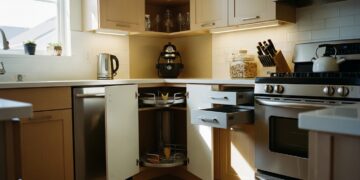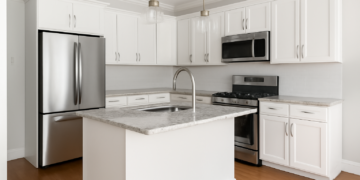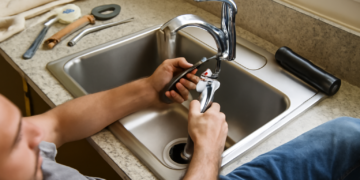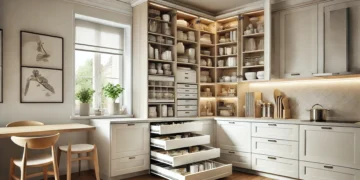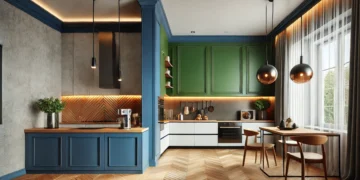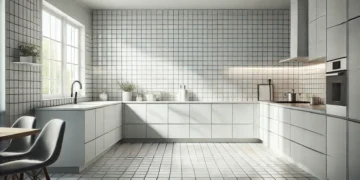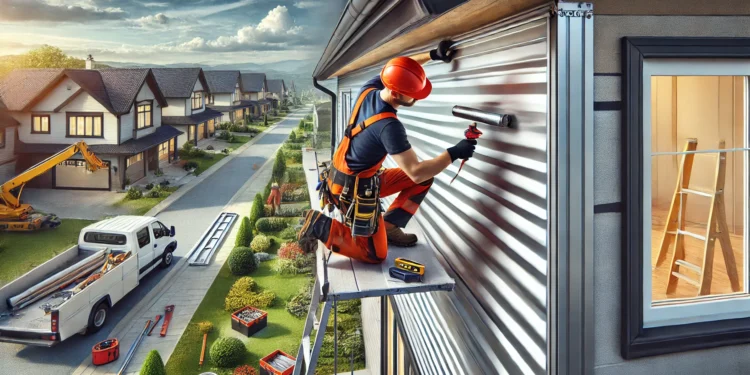When planning home renovations, the cost of aluminum siding is a major concern for many homeowners. Understanding the various factors that influence the final price is key to a successful project. This guide will walk you through the average costs, a detailed cost breakdown, and practical tips to help you budget for your home improvement project with confidence.
What is Aluminum Siding?
Aluminum siding is a popular choice for home exteriors. It’s a lightweight metal cladding system that is known for its durability. Homeowners often choose it because it resists pests and moisture, so it won’t rot or attract insects. People love aluminum siding for its long lifespan and clean look.
For more ideas on enhancing your home’s outside, you might find our article on exterior home design for small houses helpful.
You can learn more about the material’s lightweight nature and the industry standards for aluminum siding by visiting the Aluminum Association’s website.
Factors Affecting Aluminum Siding Cost
The final price of your project isn’t just about the material. Several key factors play a big role in your total expense.

1. Home Size and Architectural Complexity
This is the biggest factor affecting the cost of aluminum siding. A larger house requires more materials and more labor, which naturally increases the overall price. Additionally, homes with many corners, unique architectural details, or multiple stories will be more complex to work on. This means a higher labor cost and a longer project timeline.
2. Siding Quality and Gauge
The quality of aluminum siding directly affects its price. Higher-quality, thicker materials are more expensive upfront but offer better durability and a longer lifespan. Cheaper, lower-quality siding may seem like a bargain, but it’s more prone to dents and fading, and it may need to be replaced sooner.
3. Installation Complexity
Installing difficulty is the main factor that determines the price to replace aluminum siding. In homes that contain numerous corners, windows, or any other distinctive details, the work involved will be more. This will result in not only higher labor costs but also a longer project. When considering the design elements that can affect installation, you might find our article on home front design ideas relevant.
4. Location
Where your house is located can influence the cost. Labor rates and material prices can vary significantly by region. Urban areas often have higher costs for both labor and materials compared to rural areas. To understand more about how location impacts costs, you can explore labor and wage data from resources like the U.S. Bureau of Labor Statistics.
5. Removal of Old Siding
The total price to replace aluminum siding includes not only the new installation but also the cost to remove the old siding. This is a key line item you must include when preparing your budget. It covers the labor for removal and the disposal of the old materials. For tips on making cost-effective choices for your home’s exterior, you might find our article on affordable home decor ideas useful.
Average Cost for Aluminum Siding
It’s helpful to have a general idea of what to expect. While prices can vary, here are some typical figures:
-
Material Costs: You can expect to pay between $3 and $6 per square foot for aluminum siding materials. Thicker, higher-quality panels will be on the upper end of that range.
-
Labor Costs: Professional installation typically costs between $2 and $5 per square foot. This price can be higher for more complex projects.
Total Cost Estimates
For an average-sized home (around 2,000 square feet), the total cost of aluminum siding, including both materials and labor, generally falls in the range of $10,000 to $19,000. Remember, these are estimates, and the rates can change depending on your specific situation. You can find detailed breakdowns of these figures in construction cost reports from trusted sources like the National Association of Home Builders.
How to Budget: A Cost Breakdown
To get a more precise estimate, it helps to look at the project in three parts.

Materials
The material cost depends on the quality you choose. Basic, standard panels may cost around $3 to $4 per square foot. Heavier, more insulated, or premium-grade siding can cost upwards of $6 per square foot.
You can get a sense of the current pricing for various types of aluminum siding by browsing the websites of building materials retailers such as Lowe’s.
Labor
The labor fee is a significant part of the cost to replace aluminum siding. Professional installation typically costs $2 to $5 per square foot. For very labor-intensive or luxurious projects, these costs can be higher.
Additional Expenses
Some costs might not be obvious at first. Be sure to account for these items, as they can add 10% to 20% to your overall expense:
-
Insulation: Adding new insulation behind the siding.
-
Trim work: Replacing or adding trim around windows and doors.
-
Repairs: Fixing any damage to the underlying walls once the old siding is removed.
-
Old Siding Removal: This is a separate cost that covers the demolition and disposal of old siding.
Cost-Saving Tips for Aluminum Siding

There are several ways to reduce the overall fee for your aluminum siding project.
-
Get Multiple Quotes: Always get estimates from at least three different companies. This increases your chances of getting a great offer and helps you see what’s included in the ultimate aluminum siding cost.
-
Choose the Right Time: The cost of aluminum siding can be affected by the seasons. You might find lower prices or discounts if you schedule your project outside of the peak construction season.
-
Consider Partial Replacement: If only a few pieces of your siding are damaged, repairing just those sections is often more cost-effective. This reduces the total monetary obligation for a new installation.
-
Maintain Regularly: Routine cleaning and maintenance can extend the lifespan of your siding. By keeping it in good shape, you delay the need for a full replacement, saving you a lot of money in the long run.
Pros and Cons of Aluminum Siding
Before you make a decision, it’s good to weigh the benefits and drawbacks.
Pros:
-
Durability: It stands up to tough weather and lasts for decades.
-
Low Maintenance: It doesn’t require constant painting or repair.
-
Fire Resistance: It’s a non-combustible material, which adds a layer of safety.
-
Energy Efficiency: It can help insulate your home, reducing heating and cooling costs.
-
A Variety of Colors: You can find it in many different colors and styles.
Cons:
-
Can dent easily: It is a soft metal, so it can be dented by hail or strong impacts.
-
Noisy during rain or hail: The sound of rain on metal can be louder than on other materials.
-
It may fade over time: The color can slowly fade, especially in direct sunlight.
-
Higher initial cost: It can be more expensive than some other siding options.
You can also paint aluminum siding when you want to change the color or to make it look newer, similar to the considerations we discuss in our article on trendy exterior paint colors for ranch-style homes.
For a balanced view of the advantages and potential drawbacks of aluminum siding, including its susceptibility to denting, you might find articles on home improvement websites like DaBella informative.
Aluminum Siding vs. Other Materials

It’s smart to compare aluminum siding prices to other options. This helps you make a careful decision that fits your budget and design goals.
-
Vinyl Siding: Aluminum is generally more expensive than vinyl. However, aluminum provides better durability, fire resistance, and a longer lifespan. Vinyl is a very popular, affordable choice but may not last as long. For a detailed look at the costs and factors related to vinyl siding, you can read our comprehensive guide.
-
Fiber Cement: Fiber cement is typically more expensive than aluminum. But it is extremely durable and fire-resistant, often lasting longer than aluminum.
-
Wood Siding: Wood siding costs can vary widely. It can be cheaper or more expensive than aluminum. A major drawback of wood is the high maintenance required to keep it looking good and protected from pests and rot.
DIY vs. Professional Installation

You might be tempted to install aluminum siding yourself to save money. While a DIY project can cut down on the cost of replacing aluminum siding, it’s not always the best way. Professional installation is an excellent investment. Experts ensure the siding is fitted and sealed properly, which prevents future problems and avoids extra expenses down the line. To learn more about tackling big home projects, check out our tips on DIY bathroom remodel ideas.
Maintenance and Longevity

Properly maintaining your aluminum siding is the best way to get your money’s worth and delay a full replacement. Regularly cleaning it and fixing any small damage as soon as you notice it will greatly increase its lifespan. If you care for it well, aluminum siding can last 40 years or more.
Environmental Considerations
Aluminum siding is a great choice for eco-friendly homeowners because it is 100% recyclable. This is a significant benefit. If the upfront costs are a concern, there are several financing options available, such as home equity loans, personal loans, or contractor financing. For a detailed look at budgeting for home improvements, our article on kitchen remodeling price can provide useful insights into managing costs for other projects.
Frequently Asked Questions (FAQs)
1. What is the average cost of aluminum siding?
An average aluminum siding cost of between $3 and $6 per square foot is fairly common for material expenses, and a homeowner should add another $2 to $5 per square foot in installation costs.
2. How much does it cost for aluminum siding for a typical house?
Taking the middle road between $10,000 and $19,000 for a regular home, with some of the variables such as home size and siding quality as the determining factors.
3. Is aluminum more expensive than vinyl?
Affirmative, the price of aluminum is generally higher than the price of vinyl, but on the other hand, it provides a longer lifespan and more durability.
4. How long does the aluminum siding last?
If looked after correctly, aluminum siding can be expected to last more than 40 years.
5. Can I paint the aluminum siding?
Certainly, you can paint aluminum siding when you want to change the color or to make it look newer.
6. How often does the aluminum siding need to be replaced?
Comparatively, with the new composite cladding, aluminum siding now has a lifespan of 20-40 years on average, depending largely on maintenance and the harsh weather conditions.
7. What are the aspects that determine the cost of replacing aluminum siding?
Some of the factors that could affect the replacement are the size of the property, the quality of the siding, the complexity of the installation process, and the removal of old siding.
Conclusion
The cost of aluminum siding is impacted by several factors, including the size of your house, the quality of the materials, and the complexity of the installation. While the initial investment might be higher than for some other materials, aluminum’s longevity and low maintenance make it a valuable choice in the long run.
When you’re budgeting for aluminum siding, it’s a good idea to take a long-term view. The initial investment for aluminum is often offset by its durability and minimal maintenance needs over time. It’s recommended to get estimates from multiple companies and to consider the time of year for your installation. Finally, weighing the pros and cons of different materials will help you get the best value for your home upgrade.



